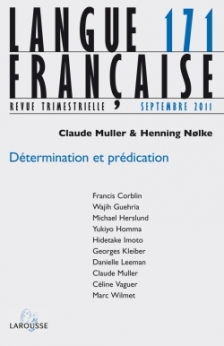
Langue française n° 171 (3/2011)
Pour acheter ce numéro, contactez-nous
Recevez les numéros de l'année en cours et accédez à l'intégralité des articles en ligne.
Nous nous proposons dans cet article d’examiner les problèmes que pose l’interprétation de « manière » du gérondif. Après avoir, dans une première partie, rappelé notre analyse du gérondif comme étant une sorte d’« avec » du verbe, nous aborderons, dans les deuxième et troisième parties, la question de la détermination, délimitation et explication des gérondifs de « manière ». Nous serons amené plus spécialement à expliquer comment des prédications qui ne peuvent a priori passer pour des « manières » du verbe de la principale peuvent accéder à ce statut si on les met au gérondif. Nous distinguerons à cet effet entre manière « intrinsèque » et manière « extrinsèque » et essaierons, après avoir justifié par des critères formels leur réunion, de décrire explicitement quelles sont les conditions de leur émergence.
In this article, we intend to consider the problems raised by the interpretation of “manner” for the gerund. After exposing our analysis of the gerund as some kind of “with” of the verb, we will tackle in the second and third parts the issues of determining, delimiting and explaining the “manner” gerunds. We will more specifically explain how predications that cannot a priori be taken as “manners” of the main clause verb can access that status if put in the gerund. For that reason, we will distinguish between intrinsic and extrinsic manners and we will attempt, after justifying by formal criteria their reunion, an explicit description of the conditions for their emergence.